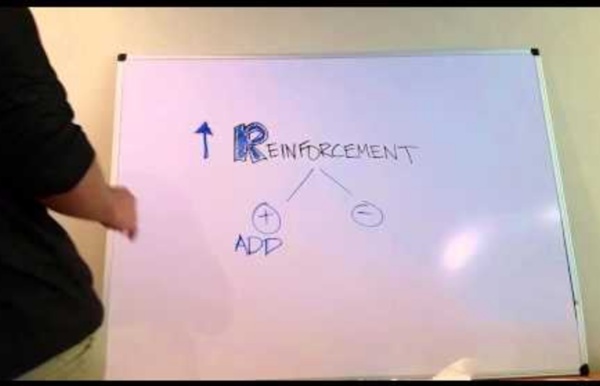



http://www.youtube.com/watch?v=278JYiPi7r8
Related: Road Safety: Reinforcement and Punishment • A Guide for Parents: Reinforcement & Punishment in Teenagers • PSY108 Student Assignment • Reinforcement and punishment guide for behavioural management in teenagers12 Examples of Positive Punishment & Negative Reinforcement You might be thinking that “positive punishment” sounds like an oxymoron, after all, how can punishment be positive? Not many people “like” punishment, right? The disconnect in understanding this concept comes from the usage of the word “positive;” here at PositivePsychology.com, we generally use the term “positive” to refer to things that are inherently good, things that are life-giving, and things that promote thriving and flourishing.
What is Negative Punishment (Examples and Effectiveness) In this article, we will review negative punishment, its definition, examples, and drawbacks. American psychologist B.F. Skinner developed the theory of operant conditioning, which stated that a person or animal’s behavior could be increased or decreased by adding or removing appropriate stimuli after the behavior is exhibited. The difference between classical conditioning and operant conditioning is that classical affects unconscious behavior, while operant affects conscious behavior. Within operant, punishment aims to reduce a behavior while reinforcement increase a behavior. Punishment or reinforcement can be positive or negative.
Operant Conditioning (B.F. Skinner) How Reinforcement and Punishment Modify Behavior Operant conditioning, also known as instrumental conditioning, is a method of learning normally attributed to B.F. Skinner, where the consequences of a response determine the probability of it being repeated. Through operant conditioning behavior which is reinforced (rewarded) will likely be repeated, and behavior which is punished will occur less frequently. By the 1920s, John B. Watson had left academic psychology, and other behaviorists were becoming influential, proposing new forms of learning other than classical conditioning.
The Effects of Positive and Negative Reinforcement By Chron Contributor Updated August 04, 2020 Positive reinforcement involves rewarding an employee for doing a good job. An example would be giving an employee a paid vacation day for exceeding monthly production goals. Negative reinforcement involves removing something undesirable to alter behavior – for example, discontinuing daily meetings with a manager to discuss job performance after an employee has raised his personal production levels. Schedules of Reinforcement: When to use positive and negative reinforcement – Parenting With Psychology I’m back at my keyboard after a few weeks’ hiatus during which I spent all my free time landscaping. I completely understand how the stereotypical scene of the stay at home mom working out in the garden developed. You can use your hands in a productive manner, making progress rather than just cleaning up and fixing things. There are small, well-defined projects that can be accomplished and checked off your list rather than the ongoing and endless refinement of child rearing. And perhaps the most appealing feature of gardening is that your plants cannot talk, whine, yell, etc.
10 Positive Punishment Techniques & Their Effect By: Ashley Brown Updated February 11, 2021 Medically Reviewed By: Laura Angers Parenting Children with Positive Reinforcement (Examples + Charts) Children don’t come with instructions and discipline is often experienced by parents and children alike as an arena where our will and wits are tested. Positive reinforcement is only one of many forms of discipline, but from the perspective of positive psychology, it may as well be the most important one as it focuses on amplifying what is already good in our children and in ourselves as their caretakers. Positive reinforcement as a form of positive discipline allows us to tap into our children’s individual strengths, draw attention to their personality traits and interests, and as a result give us an opportunity to connect, communicate effectively, and ultimately empower them to be more of themselves. Before you read on, we thought you might like to download our 3 Positive Psychology Exercises for free.
The effect of using punishment Punishment is a term used in operant conditioning to refer to any change that occurs after a behavior that reduces the likelihood that that behavior will occur again in the future. While positive and negative reinforcements are used to increase behaviors, punishment is focused on reducing or eliminating unwanted behaviors. Punishment is often mistakenly confused with negative reinforcement. The difference: Reinforcement increases the chances that a behavior will occur and punishment decreases the chances that a behavior will occur. Rewarding behavior is key to parenting teens, study suggests Parenting is hard, and parenting teens brings about an entirely new set of challenges, from keeping their rooms clean to getting them home before curfew. But, a new study suggests parents who want their teenagers to keep their grades up could have better success if they focus more on rewarding good behavior and less on threatening to punish the bad. According to the report, published in PLOS Computational Biology, British researchers have found that adolescents focus well on positive incentives, but have difficulty staying motivated to avoid penalties. The study shows that teens and adults learn in different ways, according to the study’s lead author Stefano Palminteri, a researcher with the Institute of Cognitive Neuroscience at University College London. It suggests that “in some cases positive feedback may have more of an effect than negative feedback on learning” in adolescents.
Positive vs Negative Punishment - Psychestudy Punishment is a fundamental concept of Operant Conditioning, whose major objective is to decrease the rate of certain undesired behavior from occurring again. Punishment can be further classified into two major parts These two different types of punishment have got both similarities and differences, as the major purpose of both these punishment types is to decrease the rate of certain undesired behavior. By introducing the concept of punishment to an individual, the individual gets the idea that what he/she is doing, is wrong. Positive and negative punishment, generally speaking, is the concept of adding certain unfavorable consequence or depriving the individual of certain favored item or advantage, in order to decrease the behavior. Differences Between Positive and Negative Punishment